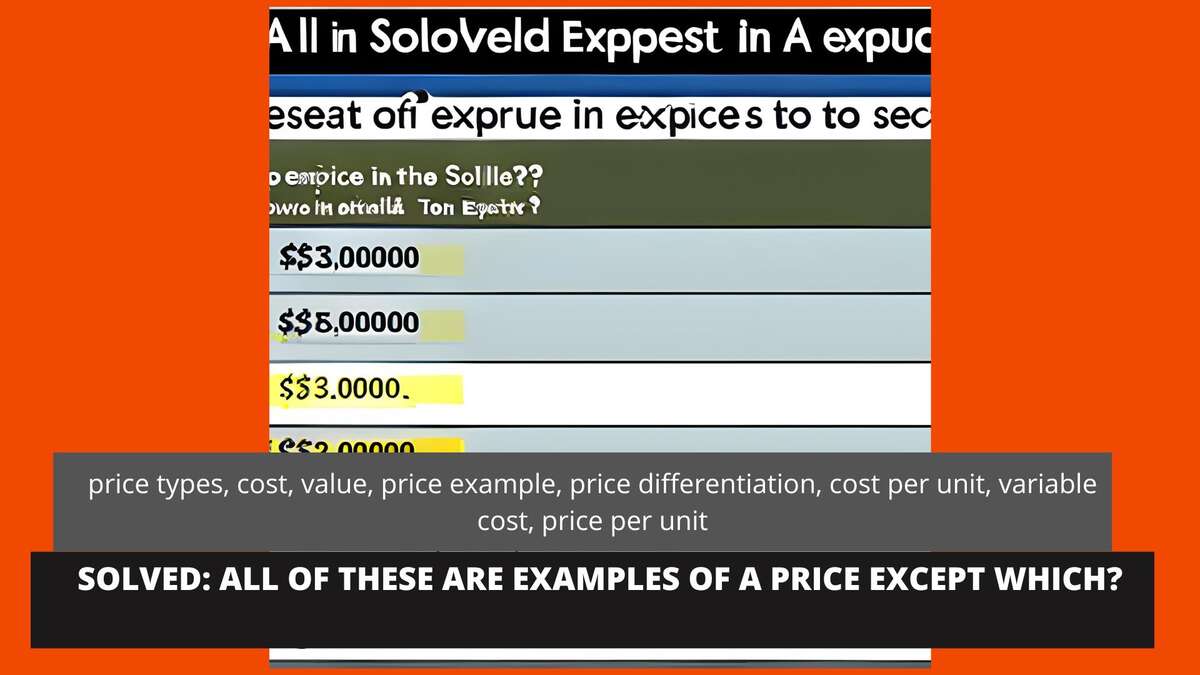Prices are essential elements in our daily lives and play a crucial role in economic transactions. They help determine the value of goods and services, influence purchasing decisions, and contribute to the overall functioning of markets. But what is a price, and how can we differentiate between various price types? In this blog post, we'll delve into the world of pricing, exploring different examples and identifying which one does not fit the category. We will also discuss the concepts of cost and value and their relation to price, as well as useful tools for calculating various costs and prices.
Understanding the Concept of Price
A price is the amount of money a buyer is willing to pay for a good or service. Prices can vary depending on various factors, such as supply and demand, production costs, perceived value, and competition. They serve as a signal for producers and consumers, guiding their decisions in the marketplace. Prices can be categorized into several types, including fixed prices, variable prices, promotional prices, psychological prices, and bundle prices. Let's take a closer look at each type.
1. Fixed Prices
Fixed prices are prices that remain constant over time, regardless of market fluctuations or changes in demand. They provide stability for both consumers and producers, allowing for better budgeting and forecasting. Examples of fixed prices include utility rates and subscription fees.
2. Variable Prices
Variable prices change depending on external factors, such as demand, supply, and market conditions. They can fluctuate over time, reflecting the constantly changing dynamics of the marketplace. Examples of variable prices include airline tickets, gasoline prices, and stock prices.
3. Promotional Prices
Promotional prices are temporary reductions in price designed to attract customers and boost sales. They are often used as part of marketing campaigns and can help companies gain market share. Examples of promotional prices include sales, discounts, and coupons.
4. Psychological Prices
Psychological prices are prices that appeal to consumers' emotions and perceptions of value. They are often set slightly below whole numbers (e.g., $9.99 instead of $10) to create the illusion of a better deal. Examples of psychological prices include charm pricing and price anchoring.
5. Bundle Prices
Bundle prices are prices for a group of products or services sold together at a discounted rate. Bundling can encourage customers to purchase more items, increasing overall sales and revenue. Examples of bundle prices include meal deals, software packages, and cable TV bundles.
Which Example Doesn't Belong?
Now that we've covered the various types of prices, let's revisit our original question: which example doesn't fit the category? The answer is: cost per unit. While prices are the amounts buyers are willing to pay for goods or services, cost per unit refers to the total cost of producing a single unit of a product or service. It includes both fixed and variable costs and is an essential component of pricing strategies, as it helps businesses determine their break-even point and profit margins.
Understanding Cost and Value
While prices represent the monetary amount assigned to goods and services, it's essential to understand the concepts of cost and value to gain a complete picture of pricing dynamics.
Cost
Cost refers to the expenses incurred in producing or providing a good or service. Costs can be divided into two main categories: fixed costs and variable costs. Fixed costs are expenses that remain constant regardless of the level of production or sales, such as rent or salaries. Variable costs, on the other hand, vary with the level of production or sales, such as raw materials or commissions. To calculate the cost per unit, you can use an online tool like the Variable Cost Per Unit Calculator or the Cost Per Unit Calculator.
Value
Value refers to the perceived worth of a good or service to a customer. Value can be subjective, as it depends on individual preferences, needs, and circumstances. When setting prices, businesses must consider the perceived value of their offerings to ensure they are competitive and appeal to their target audience.
Calculating Prices
To set appropriate prices for goods and services, businesses must consider various factors, including production costs, market conditions, and perceived value. One useful method for calculating prices is to determine the cost per unit and add a markup or profit margin. Online tools like the Price Per Unit Calculator can help you quickly and easily calculate prices based on these factors.
Conclusion
Understanding the different types of prices and their underlying concepts is crucial for making informed business decisions and navigating the complex world of pricing. By recognizing the key differences between price, cost, and value, businesses can better tailor their pricing strategies to attract customers and maximize profits. By leveraging online tools like the Variable Cost Per Unit Calculator, Cost Per Unit Calculator, and Price Per Unit Calculator, you can quickly and easily calculate and analyze various pricing metrics to make better-informed decisions.
